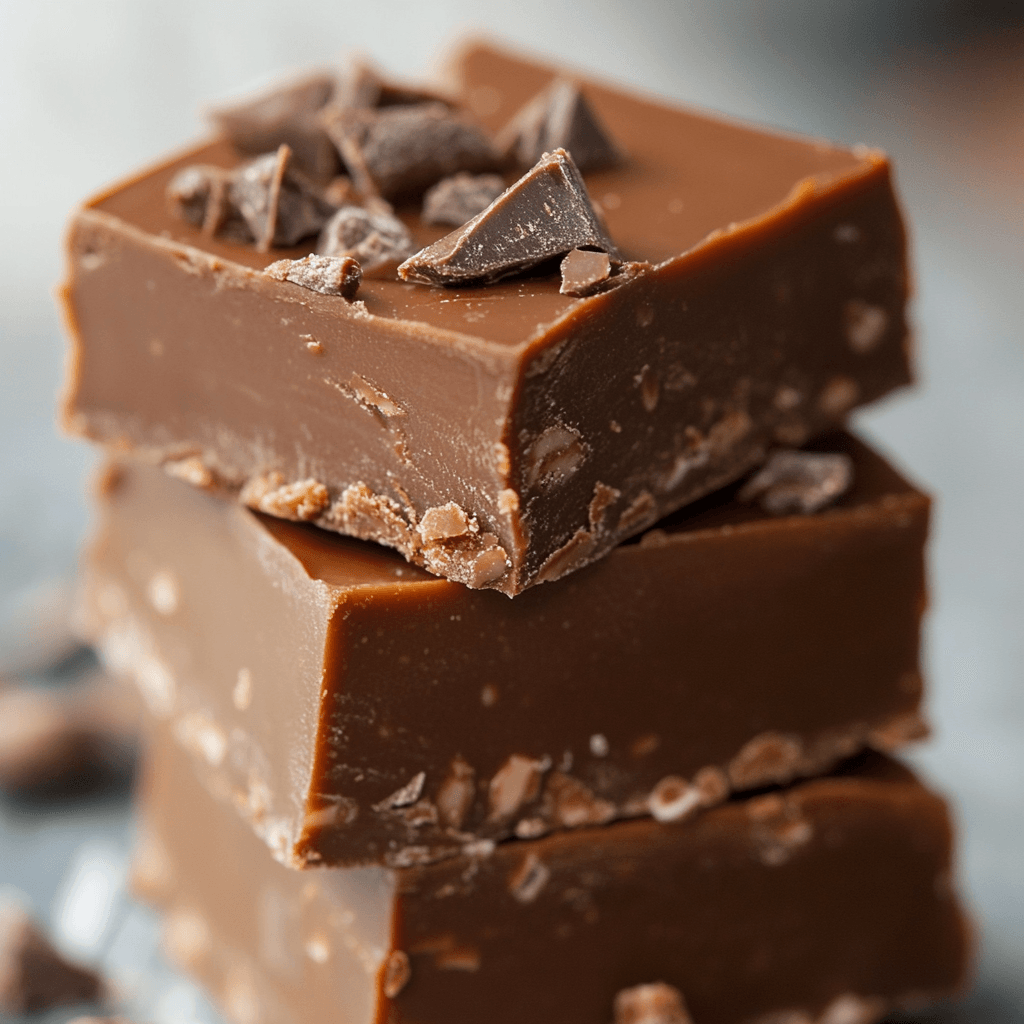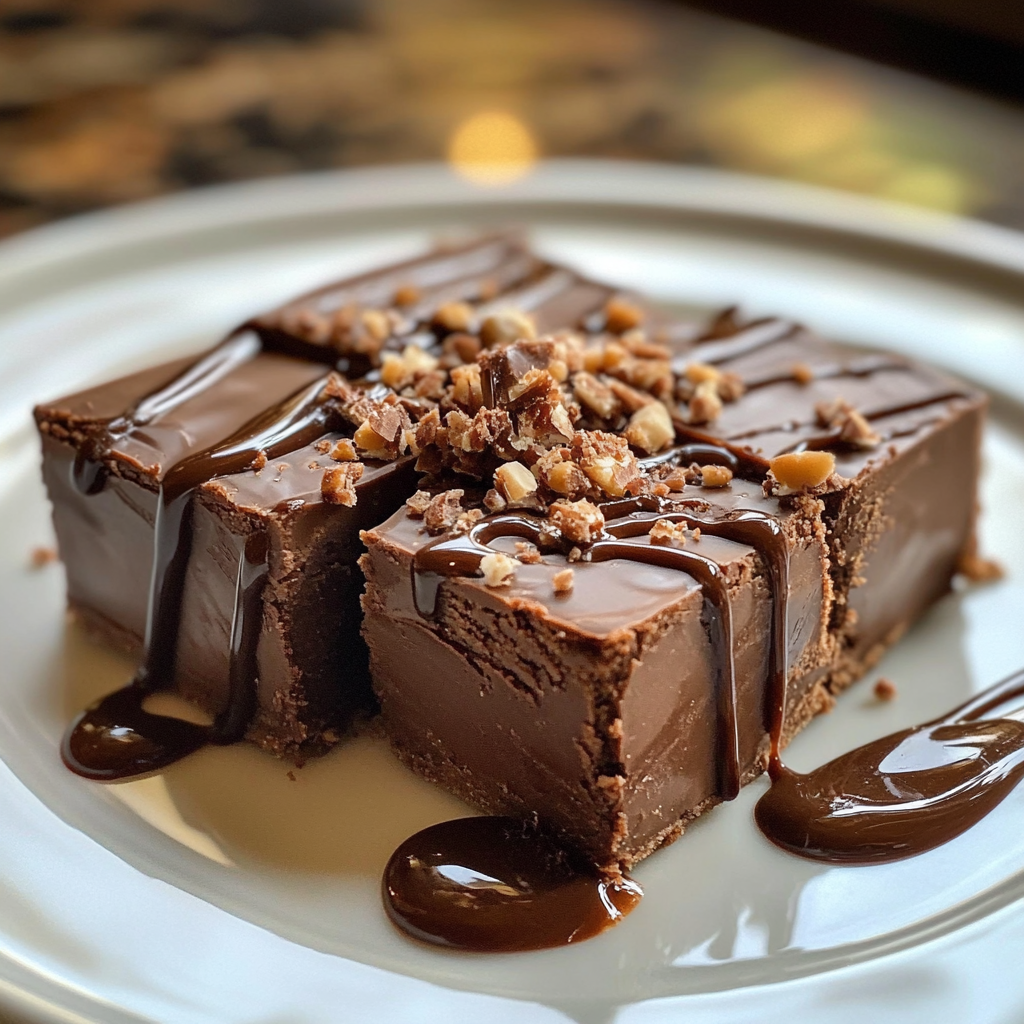Introduction to Fudge
What is Fudge?
If you’re searching for the ultimate sweet treat, this easy fudge recipe is exactly what you need. Not only is it simple to prepare, but it also delivers a rich and creamy texture that’s perfect for any occasion. Whether you’re making a quick dessert for a party or a homemade gift for loved ones, this recipe ensures delicious results every time.
Why Fudge is a Popular Dessert
Fudge is a favorite dessert for several reasons. First, its simplicity makes it accessible to everyone. Second, it can be customized with different flavors, such as classic chocolate, peanut butter, or peppermint, making it suitable for all tastes. Additionally, fudge is perfect for sharing at parties, gifting during holidays, or enjoying as a quick indulgence. Its versatility and rich flavor ensure it remains a timeless favorite.
Benefits of Making Homemade Fudge
Cost-Effective Treats
Making fudge at home is not only fun but also cost-effective. With just a few common ingredients, you can create a large batch of delicious fudge at a fraction of the cost of store-bought options. Furthermore, it allows you to make enough to share with friends and family without overspending.
Customizable Flavors
One of the best things about homemade fudge is how easily you can customize it. For example, you can add nuts, marshmallows, or dried fruits for extra texture. Additionally, you can experiment with unique flavors like salted caramel, dark chocolate mint, or white chocolate raspberry. This flexibility ensures you can tailor your fudge to suit any preference or occasion.
Easy for Beginners
Making fudge at home is surprisingly simple, even for those with little cooking experience. Most recipes use straightforward steps and require only basic tools. Moreover, some options, like microwave fudge, don’t require cooking at all. With such an easy process, anyone can create delicious fudge without much effort.
Key Ingredients for an Easy Fudge Recipe
Traditional Ingredients
Making fudge requires just a few simple ingredients that come together to create its rich, creamy texture:
- Sugar: Granulated sugar provides the sweetness and structure for the fudge.
- Butter: Adds creaminess and enhances the flavor.
- Milk or Cream: Used to create the smooth, soft texture that defines fudge.
- Chocolate: Commonly used for flavor, whether milk, dark, or white chocolate. Cocoa powder can also work as an alternative.
- Vanilla Extract: Enhances the overall flavor of the fudge.
These traditional ingredients are the foundation of any classic fudge recipe and ensure a delicious result every time.
Substitutes for Special Diets
If you need to adapt your fudge for dietary restrictions, here are some simple substitutions:
- Sugar Alternatives: Use coconut sugar, stevia, or monk fruit sweetener for a lower-sugar option.
- Dairy-Free Options: Replace butter with plant-based alternatives like coconut oil or vegan butter, and swap milk or cream for almond milk, coconut milk, or oat milk.
- Gluten-Free Adaptations: Most fudge recipes are naturally gluten-free, but always double-check labels on flavorings or add-ins to ensure they meet dietary needs.
These substitutions allow everyone to enjoy homemade fudge, regardless of their dietary requirements.
Step-by-Step Instructions for Making Fudge
Prepping Your Workspace
- Start by gathering all your ingredients and tools. You’ll need a saucepan, a wooden spoon, a candy thermometer (if required by your recipe), and a baking dish lined with parchment paper.
- Measure out your ingredients beforehand to make the cooking process smooth and stress-free.
Combining Ingredients
- In a heavy-bottomed saucepan, combine the sugar, butter, and milk (or your chosen substitutes). Stir over medium heat until the sugar dissolves completely.
- If your recipe requires it, attach a candy thermometer and continue to cook the mixture until it reaches the desired temperature (usually around 234–240°F or 112–116°C for soft-ball stage).
- Remove the pan from heat and add the chocolate, stirring until melted. For extra flavor, mix in vanilla extract or any add-ins like nuts or dried fruits at this stage.
Setting the Fudge
- Pour the fudge mixture into your prepared baking dish, spreading it evenly with a spatula.
- Let the fudge cool at room temperature until it sets. This usually takes about 1–2 hours, but you can place it in the refrigerator to speed up the process.
- Once set, remove the fudge from the pan and cut it into small squares for serving.
Step 1: Choosing the Right Base
Sweetened Condensed Milk
Sweetened condensed milk is a popular choice for making fudge because it simplifies the process and ensures a creamy texture. It eliminates the need for precise sugar and milk measurements and reduces the risk of crystallization. Simply combine it with chocolate or other ingredients, heat, and enjoy smooth, velvety fudge.
Marshmallow Cream
Marshmallow cream (or fluff) is another excellent base for fudge. It helps stabilize the mixture and creates a light, airy texture. Recipes using marshmallow cream often involve melting it with butter, sugar, and milk to create a smooth, rich foundation for your fudge.
Step 2: Mixing and Heating
Maintaining the Right Temperature
Temperature control is critical when making fudge. If you’re using a candy thermometer, aim for the soft-ball stage (234–240°F or 112–116°C) for classic recipes. Stir continuously to prevent burning and ensure the sugar dissolves completely. If you overheat the mixture, it may become grainy, so maintaining the right temperature is essential for a smooth result.
Adding Flavors
Once the mixture is heated to the correct temperature, remove it from the heat and stir in your chosen flavors. Classic options include vanilla extract or melted chocolate, but you can get creative with peppermint, almond, or caramel extracts. Add-ins like chopped nuts, dried fruits, or crushed candy canes can also elevate your fudge and make it unique.
Step 3: Pouring and Cooling
Ideal Pans for Fudge
The choice of pan can impact the final product. A square or rectangular baking dish (8×8 or 9×9 inches) works best for even cooling and cutting. Line the pan with parchment paper, allowing the edges to hang over for easy removal once the fudge has set.
Cooling Times for Best Texture
Proper cooling is essential for achieving the right texture. Let the fudge cool at room temperature for 1–2 hours until firm. For faster results, you can refrigerate it, but avoid freezing, as this may alter the texture. Once cooled, lift the fudge out of the pan using the parchment paper and slice it into squares for serving.
By following these steps, you’ll ensure that your fudge is smooth, flavorful, and perfectly set every time!
Popular Fudge Variations
Classic Chocolate Fudge
Classic chocolate fudge is a timeless favorite. Made with rich cocoa or melted chocolate, butter, sugar, and milk or sweetened condensed milk, it’s a simple recipe that delivers creamy and indulgent results. For a traditional twist, add a splash of vanilla extract or sprinkle chopped nuts on top.
Peanut Butter Fudge
Peanut butter fudge offers a smooth, nutty alternative to the classic chocolate version. This variation combines peanut butter with butter, sugar, and milk to create a rich and flavorful treat. For an extra layer of decadence, drizzle melted chocolate over the top or swirl it into the fudge before setting.
White Chocolate Cranberry Fudge
White chocolate cranberry fudge is a festive and visually appealing option, perfect for holidays or special occasions. The sweetness of the white chocolate pairs beautifully with the tartness of dried cranberries. To make it even more decorative, sprinkle chopped pistachios or a pinch of sea salt over the top for added flavor and texture.

Tips for Perfecting Your Easy Fudge Recipe
Preventing Grainy Texture
A grainy texture is one of the most common challenges when making fudge. To prevent this:
- Dissolve the Sugar Completely: Stir the mixture continuously while heating to ensure the sugar fully dissolves.
- Avoid Stirring After Boiling: Once the mixture begins to boil, stop stirring to avoid introducing sugar crystals.
- Cool Properly: Allow the mixture to cool slightly before stirring or beating, as this helps achieve a smooth consistency.
Enhancing Flavor with Add-Ins
Adding extra ingredients can take your fudge to the next level. Some ideas include:
- Nuts: Chopped walnuts, almonds, or pecans add crunch and depth of flavor.
- Fruits: Dried cranberries, cherries, or orange zest provide a sweet-tart contrast.
- Spices: A pinch of cinnamon, nutmeg, or cardamom can elevate the flavor profile.
- Toppings: Sprinkle sea salt, crushed candy canes, or colorful sprinkles on top for added flair.
By following these tips and exploring popular variations, you can create fudge that’s not only delicious but also uniquely suited to your tastes and occasions.
Creative Ways to Serve and Gift Fudge
Decorative Wrapping Ideas
Fudge makes a delightful homemade gift, especially when presented creatively. Here are some ideas:
- Gift Boxes: Place squares of fudge in a decorative box lined with parchment paper for a professional look.
- Cellophane Bags: Wrap individual pieces in wax paper and place them in clear cellophane bags tied with ribbon for an elegant touch.
- Mason Jars: Layer fudge pieces in mason jars and secure the lid with a festive bow or tag.
- Custom Labels: Add handwritten or printed labels with the fudge flavor and a short message to personalize the gift.
Serving Suggestions for Parties
Fudge is always a hit at parties, and how you serve it can make it even more appealing:
- Dessert Platters: Arrange different fudge flavors on a platter alongside fruits, cookies, or other treats for variety.
- Fudge Bites: Cut fudge into bite-sized pieces and serve them on toothpicks or mini skewers for easy handling.
- Themed Presentation: Use molds to shape fudge into seasonal designs, such as hearts for Valentine’s Day or trees for Christmas.
- Fudge Tower: Stack fudge squares in a pyramid on a decorative plate for an eye-catching centerpiece.
Common Mistakes and How to Avoid Them
Overheating Ingredients
Overheating is a common mistake that can result in dry or grainy fudge. To avoid this:
- Monitor the Temperature: Use a candy thermometer and heat the mixture to the correct temperature, typically 234–240°F (112–116°C).
- Stir Consistently: Stir gently to prevent the mixture from sticking or burning.
- Avoid High Heat: Use medium heat instead of high to ensure the ingredients cook evenly without scorching.
Incorrect Storage
Improper storage can affect the texture and flavor of your fudge. Here’s how to store it correctly:
- Room Temperature: Keep fudge in an airtight container at room temperature for up to a week. Avoid storing it in humid areas, which can make it sticky.
- Refrigeration: If you need to store fudge longer, place it in the fridge. Wrap it tightly in plastic wrap or place it in an airtight container to prevent drying out.
- Freezing: For long-term storage, freeze fudge by wrapping it in parchment paper, then plastic wrap, and sealing it in a freezer-safe bag. Thaw at room temperature before serving to maintain the texture.
By following these tips for serving and gifting fudge creatively, along with avoiding common mistakes, you can ensure your fudge is both delightful to eat and impressive to share.
Storing and Preserving Fudge
Room Temperature Storage
Fudge can be stored at room temperature if you plan to enjoy it within a week. To keep it fresh:
- Use Airtight Containers: Place fudge in an airtight container to prevent it from drying out or absorbing odors.
- Layer with Parchment Paper: If stacking pieces, use parchment or wax paper between layers to avoid sticking.
- Keep in a Cool Spot: Store fudge in a cool, dry place away from direct sunlight or heat to maintain its texture and flavor.
Freezing Tips for Long-Term Storage
For longer preservation, freezing fudge is an excellent option. Follow these steps for best results:
- Wrap Properly: Wrap each piece or block of fudge tightly in parchment paper or plastic wrap to prevent freezer burn.
- Use Freezer Bags or Containers: Place wrapped fudge in a freezer-safe bag or container for added protection.
- Label and Date: Clearly label the packaging with the type of fudge and the date to keep track of its freshness.
- Thaw Gently: To serve, thaw the fudge at room temperature for a few hours. Avoid microwaving, as it may alter the texture.
Easy Fudge Recipe for Special Occasions
Holiday-Themed Fudge
Fudge is a perfect treat for the holidays because it’s both festive and easy to make. Consider these holiday variations:
- Peppermint Fudge: Add crushed candy canes for a seasonal twist. Sprinkle them on top before the fudge sets for a decorative look.
- Red and Green Swirls: Use food coloring to create swirls of holiday colors in white chocolate fudge.
- Spiced Fudge: Add a pinch of cinnamon, nutmeg, or ginger for a cozy, winter-inspired flavor.
Fudge for Birthdays and Anniversaries
For special celebrations, fudge can be customized to suit the occasion:
- Birthday Cake Fudge: Incorporate colorful sprinkles and vanilla extract into white chocolate fudge to mimic the flavor of birthday cake.
- Chocolate-Covered Strawberry Fudge: Layer strawberry-flavored fudge with a layer of chocolate fudge for a decadent, romantic dessert.
- Personalized Shapes: Use silicone molds to create fudge in fun shapes like hearts, stars, or numbers to reflect the celebration theme.
By following these storage tips and customizing fudge for special occasions, you can ensure that this sweet treat stays fresh and makes every celebration even more delightful.
NutNutritional Information
Balancing Indulgence with Health
Fudge is undoubtedly a rich and indulgent treat, but it can still be enjoyed responsibly. For instance, practicing portion control and balancing it with healthy meals allows you to satisfy your sweet tooth without overindulging. Moreover, pairing a small piece of fudge with fruits or nuts can add more balance to your diet. While it’s tempting to have more, treating fudge as an occasional indulgence helps maintain a healthy lifestyle.
Adjusting Ingredients for Fewer Calories
If you’re looking to make fudge a bit healthier, there are several easy adjustments to try:
- Reduce Sugar: For example, replacing regular sugar with alternative sweeteners like stevia, monk fruit, or coconut sugar can lower the calorie count significantly.
- Swap Fats: Instead of butter, using coconut oil or low-fat margarine creates a lighter version.
- Add Nutrient-Dense Ingredients: By incorporating nuts, seeds, or dried fruits, you can enhance the nutritional value while still keeping it delicious.
- Portion Control: Cutting fudge into smaller squares ensures you enjoy its flavor while consuming fewer calories.
Frequently Asked Questions About Fudge
What is the secret to good fudge?
The key to good fudge lies in precise temperature control and proper stirring techniques. For instance, heating the mixture to the correct temperature (234–240°F or 112–116°C) ensures the right consistency. Additionally, avoid over-stirring once it begins boiling, as this can cause sugar crystals to form and make the fudge grainy. Furthermore, cooling the mixture slightly before beating helps achieve a smooth, creamy texture.
What are the ingredients for fudge?
Traditional fudge recipes use basic ingredients such as sugar, butter, and milk. However, many variations include chocolate, cocoa powder, or marshmallow cream for added flavor. In addition, vanilla extract, nuts, or dried fruits can be mixed in to create customized versions.
Is it better to use evaporated milk or sweetened condensed milk for fudge?
Both evaporated milk and sweetened condensed milk work well for fudge, but they serve different purposes. For example, sweetened condensed milk is ideal for no-fail recipes because it simplifies the process and adds creaminess. On the other hand, evaporated milk is commonly used in traditional recipes that involve cooking and separately adding sugar for precise control.
Why is my 3 ingredient fudge not setting?
If your 3 ingredient fudge isn’t setting, several factors might be at play:
- Insufficient Heating: For example, failing to reach the proper temperature (around 234°F or 112°C) can leave the mixture too soft.
- Incorrect Ratios: Adding too much liquid or not enough chocolate can result in a runny texture.
- Improper Cooling: Allowing the fudge to cool undisturbed at room temperature or in the fridge is essential for proper setting.
By addressing these issues and making small adjustments, you can achieve the perfect fudge consistency every time.
What’s the best way to store leftovers?
Keep leftovers in an airtight container in the fridge for up to 4 days. Reheat in the microwave or oven until hot and bubbly. For food safety tips, refer to USDA guidelines on leftovers .
For those looking to expand their dessert repertoire, try pairing your fudge with the ultimate guide to Toll House chocolate chip cookies for a classic combination. Additionally, if you’re experimenting with flavors, consider incorporating tips from the perfect German chocolate cake recipe to inspire a rich, chocolatey twist. Finally, for special occasions, create a dessert spread by including ideas from the ultimate guide to Nestle chocolate chip cookie recipes alongside your homemade fudge.
Conclusion: Why Fudge is the Perfect Dessert
Summarizing its Simplicity and Versatility
Fudge stands out as the perfect dessert because it combines simplicity with endless versatility. Its straightforward recipes and minimal ingredient requirements make it accessible to everyone, from beginner cooks to seasoned bakers. Moreover, its adaptability allows you to experiment with flavors, textures, and add-ins, making each batch uniquely your own.
Whether you’re preparing fudge for a holiday celebration, a special gift, or just to satisfy your sweet tooth, it delivers every time. Its rich, creamy texture and customizable options ensure it remains a timeless treat that can be enjoyed by all. Ultimately, fudge isn’t just a dessert—it’s a delightful tradition that brings joy and indulgence to any occasion.






3 thoughts on “The Ultimate Guide to an Easy Fudge Recipe”
Comments are closed.